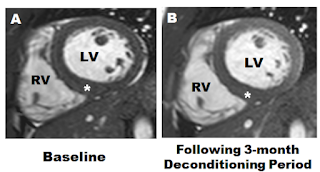An Approach to Heart Failure and Pulmonary Edema on Chest X-ray
It is important to note that pulmonary edema in the lungs follows, a certain pattern of progression, which will show up on imaging. Understanding of these imaging findings requires first and understanding of heart pressures and an underlying pathophysiology of heart failure.
One of the most important underlying features of left sided heart failure is elevated left-sided heart pressures. In many cases with impaired systolic function, the left ventricle is unable to eject blood forward and therefore there will be elevated chamber pressures in both the left ventricle and left atrium. After a prolonged period of time, there will be a retrograde transmission of elevated pressure into the pulmonary veins (which are directly connected to the left atrium). If the pressures are high enough, it will cause transudation of fluid outside of the pulmonary veins into the interstitium surrounding the alveoli, and eventually transudation of fluid directly into the air spaces.
These sequential steps in left sided heart failure also produce characteristic imaging findings which corresponds to the stage of pulmonary edema.
These three distinct stages are:
1.) Pulmonary venous congestion
2.) Pulmonary interstitial edema.
3.) Pulmonary alveolar edema
While it is difficult to directly measure, left atrial pressure, there is a surrogate for this, and it is pulmonary capillary, wedge pressure (PCWP). Is Sepand in the catheter lab where a catheter is advanced into the right atrium than the right ventricle and advanced all the way maximally to the pulmonary capillaries. The pressure reading at the pulmonary capillaries is a direct measure of left atrial pressure. A normal PCWP is between 8-12mmHg, meaning a normal left atrial pressure is also between 8-12 mmHg.
Pulmonary Venus congestion occurs at a PCWP of 13 - 18 mmHg, pulmonary interstitial oedema occurs at a PCWP of 18 - 25 mmHg, and finally alveolar edema occurs at PCWP of > 25 mmHg.
Imaging Findings:
Pulmonary Venous Congestion
This is the first stage of heart failure, and imaging findings can be very subtle. In the lungs, the pulmonary vessel supplying the upper lung fields are smaller and fewer number, and those at the long bases. This can be identified as the upper lung fields are often more lucent and darker than the lower lung fields.
In the following imaging to be clearly seen that there are higher calibre than normal pulmonary vans in the upper lung fields. There are not yet any findings of interstitial or alveolar pulmonary oedema and this represents an early sign of heart failure. This may be also called civilization, vascular, redistribution, or stags antlers sign.
Case courtesy of Calum Worsley, Radiopaedia.org, rID: 91249
The following picture from the website, Radiology Assistant also demonstrates a picture of a patient in good condition on the left, and during a period of CHF, where we can clearly see increase vascular predominant in the upper lung fields, again representing vascular, distribution or cephalization. This is an example of pulmonary Venous congestion.
Pulmonary Interstitial Edema
In pulmonary interstitial edema, the pressures inside the venous system are elevated enough that fluid translates across the endothelial lining of pulmonary veins into the tissue between the vessels and the alveoli this gives the characteristic wet appearance in the lungs and occurs at left atrial pressures between 18 to 25 mmHg.
The radiographic features of pulmonary interstitial oedema include Peribronchial cuffing, Kerley B lines, and thickening of the interlobar fissures.
In the following image, not only can vascular redistribution be seen, but also features of pulmonary interstitial edema, including Kerley B lines, thickening of interlobar fissures, and cardiomegaly.
Case courtesy of Abeer Ahmed Alhelali, Radiopaedia.org, rID: 51448
Pulmonary Alveolar Edema
The final stage of pulmonary oedema is alveolar edema. In this stage fluid continues to leak out of the vessels, into the interstitium, and into the air spaces themselves. This occurs at left atrial pressure is greater than 25 mmHg.
Radiographic features of pulmonary alveolar edema include opacities in the lung fields that are fan-shaped outwards from the hilum in a "batwing" pattern. The opacities may look like dispersed cotton balls in the lung – this is very characteristic of pulmonary alveolar edema finally air bronchograms, pleural effusions, and cardiomegaly are often also seen in this stage of pulmonary edema.
In conclusion, acutely decompensated heart failure can have different patterns in the lungs and correspond to the progression of disease, which in order are: pulmonary venous congestion, pulmonary interstitial edema, and pulmonary alveolar edema.
References:
-AM-














